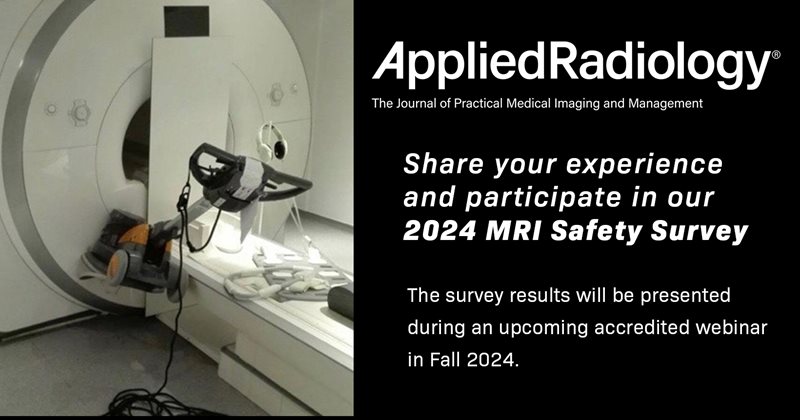Mitigating MRI Safety Risks | What The Radiologist Needs To Know
Participate in Applied Radiology’s 2025 MRI Safety Survey
As MRI safety continues to evolve, the American College of Radiology’s (ACR) Committee on MRI Safety updates the ACR Manual on MRI Safety with critical information for MRI practitioners, technologists, administrators, patients and other healthcare personnel. The ARC Manual on MR Safety, recently published in May 2024, addresses numerous MRI safety-related topics with substantial new content for MRI clinical settings.
Focusing on the importance of MRI Safety, Applied Radiology conducts an annual MRI Safety Survey, offering participants the opportunity to share their experience with a wider imaging audience. “The results of the 2023 survey were surprising in some respects,” stated Bill Faulkner, BSRT (R) (MR) (CT), FSMRT, MRSO (MRSC™), CEO of William Faulkner & Associates. Faulkner, a credentialed MR Safety Officer, a recognized expert in MR Safety, and founding board member of the American Board of Magnetic Resonance Safety (ABMRS), offers MRI safety and clinical operations consulting, as well as MRI education to his clients.
“MRI safety standards are very, very important. When people don't adhere to standards, they end up with safety issues,” he said. He further stressed the importance of following updates within the ACR Manual on MR Safety and using the survey’s results to address safety gaps in MRI facilities.
Key Findings from the 2023 MRI Safety Survey
The survey gathered 228 responses from MR technologists, radiologists, MR Safety Officers (MRSO), MR Medical Directors (MRMD) and administrators from 89 countries around the world. Results showed that 57% of respondents said either the MR technologist or the MRSO is responsible for the safety of the patient undergoing an MRI exam. However, according to the 2020 ACR Manual on MR safety (published at the time of the 2023 survey), the supervising radiologist is responsible for patient safety. Yet only 42.5% of respondents indicated this correct answer.
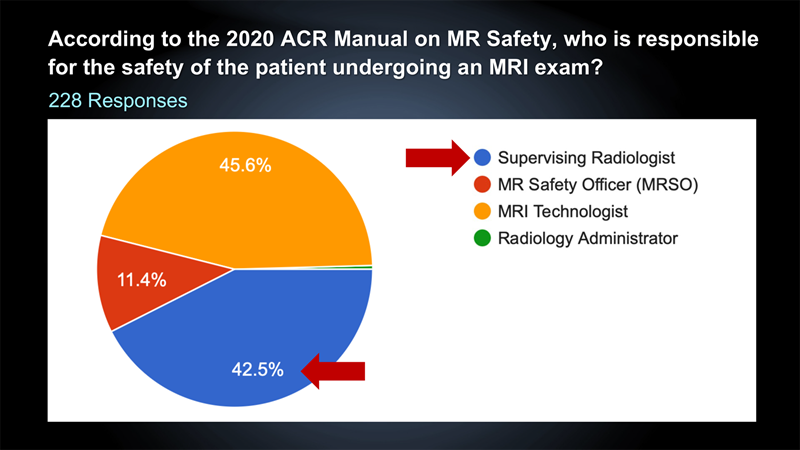
Approximately 53% of respondents said MRI techs are responsible for implementing MRI safety policies and procedures and ensuring that the facility’s personnel always adhere to them. However, according to the ACR, it’s the site’s administration or management that is responsible for this.
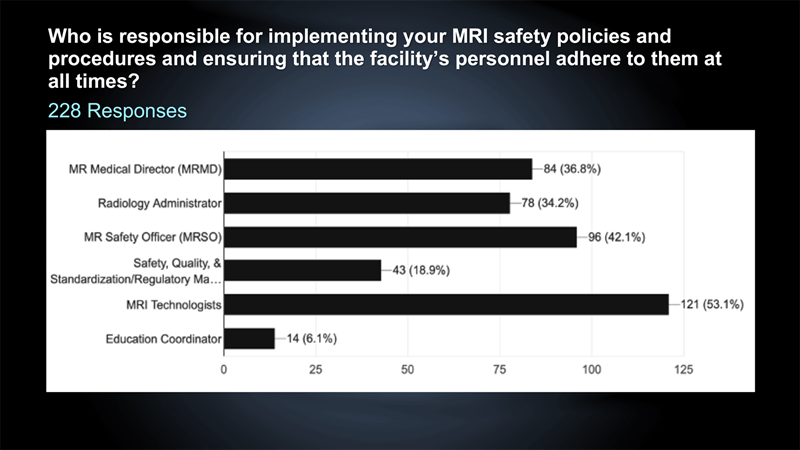
“When a patient walks into an MRI facility, they become the patient of the radiologist. The decision to scan or not, based on safety, is a medical decision that can't be made by non-licensed medical personnel,” Faulkner explained. “While it’s true that MRI technologists have a role in the safety of patients, the ultimate responsibility lies with the radiologist supervising the exam, whether they’re on site or remote. MRI technologists are the last line of defense, but safety risks are greatly increased when they are the only line of defense. Therefore, MRI technologists are meant to implement safety, not determine safety in the MRI environment.”
Approximately 67% of respondents selected someone other than the radiologist or MRMD as being responsible for ensuring that safe practice guidelines for MRI safety are established, maintained and current. The 2020 ACR Manual on MR Safety states an MRMD, MRSO or MR Safety Expert (MRSE) should support the implementation and management of MR safety in and around MRI facilities. “This indicates to me that many facilities do not have the active participation of a radiologist and/or MRMD in the development of MRI safety processes and practices,” said Faulkner.

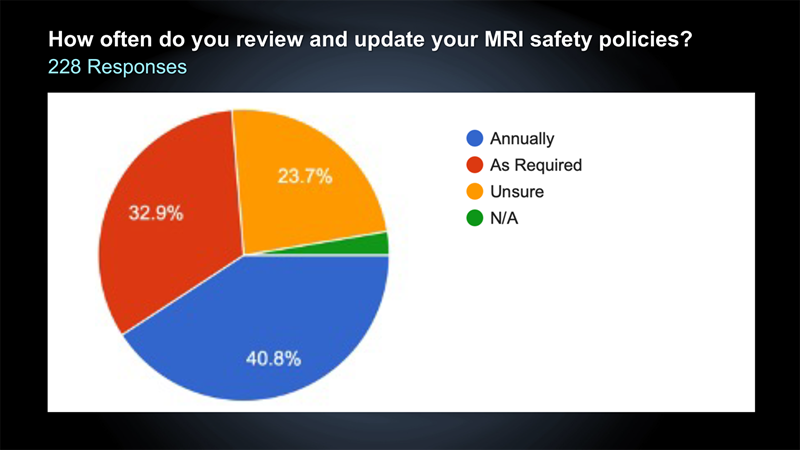
More than 58% of respondents said their MRI facilities have a designated MRMD who is responsible for setting the safety policies, procedures and standards for that facility. Just over 54% said they have an MRSO with advanced MRI safety training. The ACR Manual on MR safety states that each site will name an MR Medical Director and that MR Medical Director is responsible for determining the safety policies and procedures appropriate for that site. Further, MRMDs and MRSOs should work jointly to determine the safety policies and procedures for that site. But this is only a regulation, not a requirement, which Faulkner said is part of the challenge in ensuring MRI safety.

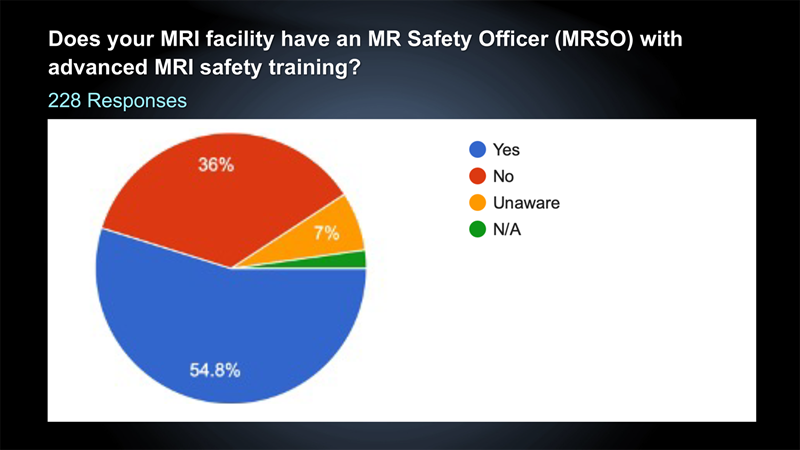
“Healthcare regulations are only as good as the people regulating it. And if the people regulating it aren't trained and credentialed, then it's just a matter of luck. Most people make the determination of safety based on assumption. So it only works well until it doesn't. And when it doesn't, you have massive safety accidents,” he said.
Respondents said all their MRI-trained technologists undergo annual MRI safety training. But only 42.1% said all their MRI-trained radiologists get annual safety training, and more than 51% said “no” or they’re “unaware” if all the MRI-trained radiologists undergo annual MRI safety training. “This should make everyone stop and think. It means over half of facilities don’t require the people responsible for the safety of patients undergoing an MRI exam undergo annual MRI safety training,” said Faulkner.
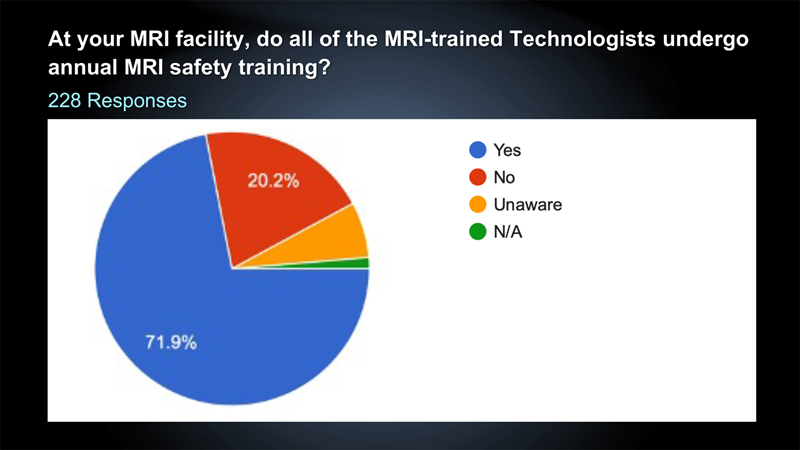

Faulkner said one of the most troubling results is that only 37.3% of the survey’s respondents reported practicing an annual “mock code” to include the emergent removal of the patient from the MRI system room. “For radiologists, this should be concerning. If the staff, who operates under the direction and the supervision of a radiologist, is not able to properly care for a patient in the event of a medical emergency, this can result in a significant issue for the radiologist,” said Faulkner.

In 2020, a patient and his family were awarded $10.83 million due to permanent neurologic damage resulting from a delay in care following an adverse event in MRI.1 “This is why radiologists should be concerned about providing services at a facility that does not plan, prepare and practice for a medical emergency in MRI. If your facility can’t adequately get your patient out of that room safely and effectively, and that delays treatment for that patient, it’s a big problem for the radiologist, as well as the facility,” said Faulkner.
Safety advice for facilities
These survey results underscore the importance of establishing and following safety standards in accordance with the latest ACR Manual on MR Safety. “Whether you agree with these standards or not, they’re what you're expected to live up to. And it’s important to not just assume you have the appropriate safety training or standards in place,” said Faulkner. The first important initiative to take is making sure your facility is appropriately staffed with safety-trained clinicians. “It’s important to have multiple layers of safety, and safety is found in redundancy. If you have only a single layer, it raises the level of risk,” he said.

Faulkner also advises radiologists to focus on their own safety training and standards. “Don't assume what you're doing is safe. Look at safety standards and look into getting credentialed with the American Board of Magnetic Resonance Safety (ABMRS) as an MRMD, and look to safety experts. When you have standards and credentials, you're making a huge step forward in MRI safety.”
Participate in Applied Radiology’s 2024 MRI Safety Survey. The results will be shared in the 2024 MRI Safety Updates | What the Radiologist Needs to Know accredited webinar, coming Fall 2024.
